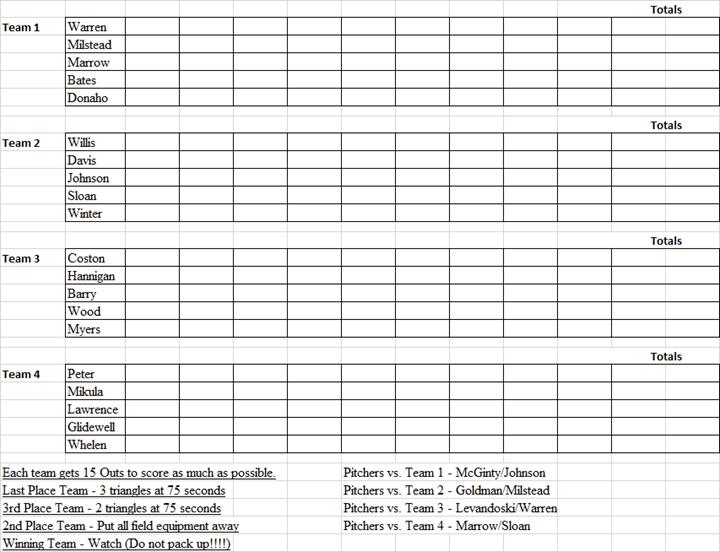Do Your Job
Do Your Job Game (DYJ)
Stratford High School
Jason Willis – Head Baseball Coach (Bio)
Over the last few years, my staff and I have used a format for inter-squad scrimmages that we feel enhances our philosophy of how we want the players to play, as well as get their competitive juices flowing. We call it DYJ, or the Do Your Job game. We start by breaking the players up into closely matched teams of four or five, being mindful that we have at least one player for each defensive position regardless of the group that is hitting. Each group gets 12-15 outs to score as many points as possible.
As we were deciding how points could be amassed, we wanted to emphasize the little things that can help win ball games. We gave them traditional ways to score points, such as getting 1 point for each total base they accrue on singles, doubles, triples, etc., but we also wanted to emphasize the little things such as sacrificing the runner over, or hitting behind the runner. Sometimes, in inter-squads, the players will lose focus, or not take it as seriously as they should. For this, we instituted a section of penalties that can be accrued as well.
|
Ways to score points |
|
|
Ways to get negative points |
|
|||
|
Single or well hit ball that's an out +1 |
Strikeout -2 |
|
|||||
|
Double +2 Triple +3 HR +4 |
Not Hustling -2 |
|
|||||
|
SAC (bunt or fly) +2 |
Failure to move runner on a hit ball-2 |
||||||
|
Score +1 |
Stupid base running -3 |
|
|||||
|
Move runner on an out (not a SAC +1) |
Error on defense -2 |
|
|||||
|
Take an extra base +2 |
Mental Error -2 |
|
|||||
|
***Leadoff is DOUBLE POINTS |
|
|
Arguing a ruling -3 |
|
|
||
Here’s an example of how 3 outs may be scored. Let’s say the leadoff batter doubles (+2 for the double, +2 more for starting the inning positively), the 2nd batter sac bunts him to 3rd (+2), the 3rd batter hits into 4-3 out, but scores the runner (+1 for the run and +1 for advancing the runner on an out), the 4th batter hits a routine grounder and gets on by an error (the batter gets no points, but the defensive player gets -2 for his group) and the 5th batter lines out to SS (+1 for a well hit out). In the 1st 3 outs, that group scored 9 points and one of the other groups has -2 because of a fielding error.
We have a couple of different ways that we can control the flow of the game. If we want to emphasize getting on and off the field, we can have the groups switch every 3 outs or 6 outs. If we are constrained by time, we can allow each group to take all of their outs before switching. This cuts down on the time taken to get on and off the field. Also, if you have multiple players at some positions, you can have them switch every three outs, as well. We have used coaches, machines and actual players to do the pitching during the game. If we use coaches or machines, any batted ball off the L screen is a do-over. If we use live pitchers, every batter starts with a 1-1 count.
Below is the actual chart we have our managers use to keep score for us during the game. He will keep a running tally out beside the name of each person in the group and we will total it up at the end. The kids really enjoy the game, and it helps us develop their baseball IQ and mentality. If you have any questions, please feel free to contact me at jason.willis@springbranchisd.com .

![]()